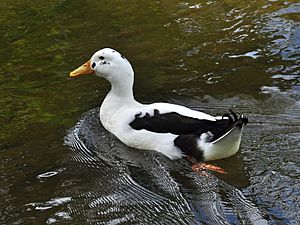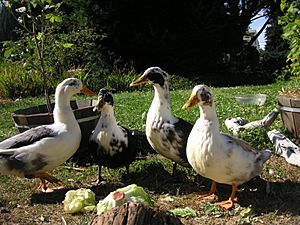Ancona duck facts for kids

|
|
| Conservation status |
|
|---|---|
| Country of origin |
|
| Traits | |
| Weight |
|
| Egg color | variable |
| Classification | |
| APA | not recognised |
| EE | not recognised |
| PCGB | not recognised |
|
|
The Ancona is a special type of domestic duck. It has a very unusual and changing feather pattern. This pattern looks like irregular patches of color on a white background. It's not completely clear if this duck breed first came from the United Kingdom or the United States. Major poultry groups like the American Poultry Association do not officially recognize it.
Where Did the Ancona Duck Come From?
People often say the Ancona duck was first bred in England in the early 1900s. It might have come from the same family of ducks as the Magpie duck. The Ancona duck was then brought to the United States around the 1970s. It was first shown there in 1983.
However, an old article from 1913 tells a different story. It says a duck with the same name was created by W.J. Wirt in Knowlesville, New York. He named it after the Ancona chicken breed. These ducks were shown at poultry events. They even won two first prizes at a big show in Boston in 1915. The Livestock Conservancy doesn't fully describe these early American Anconas. So, we don't know for sure if they were the same as the Ancona ducks we see today.
What Does an Ancona Duck Look Like?
The Ancona is a medium-sized duck. It usually weighs about 5 to 6.5 pounds (2.3 to 2.9 kilograms). It has an oval-shaped head and a slightly curved bill.
Its feathers have a "broken-colored" pattern. This means it has irregular patches of color on a white background. The most common color is black and white. But you can also find Anconas in blue and white, chocolate and white, silver and white, or lavender and white.
The duck's bill is yellow, often with black or dark green spots. Its legs and feet are orange, with black or brown marks.
Ancona ducks are good at finding their own food. They are also very tough and can live well in many different environments.
Why Are Ancona Ducks Special?
The Ancona duck is a great egg layer. It can lay about 210 to 280 eggs each year! The eggs can be many different colors. They might be blue, green, white, spotted, cream, or have a light tint.


